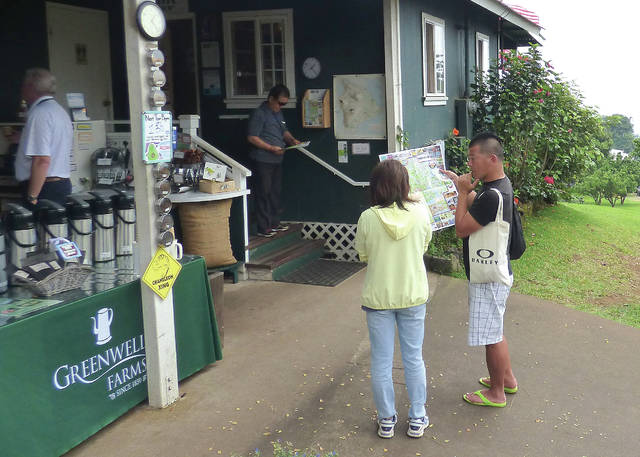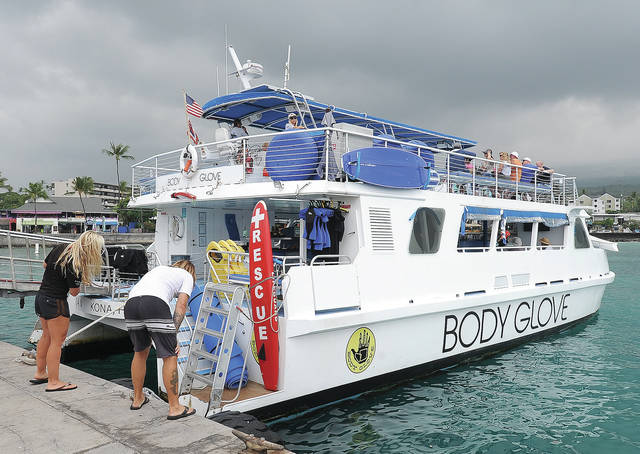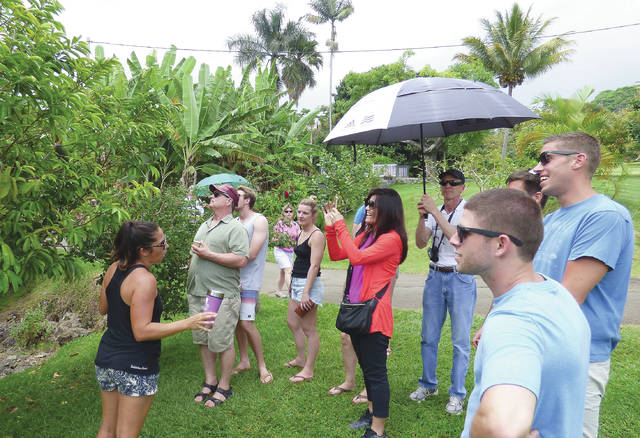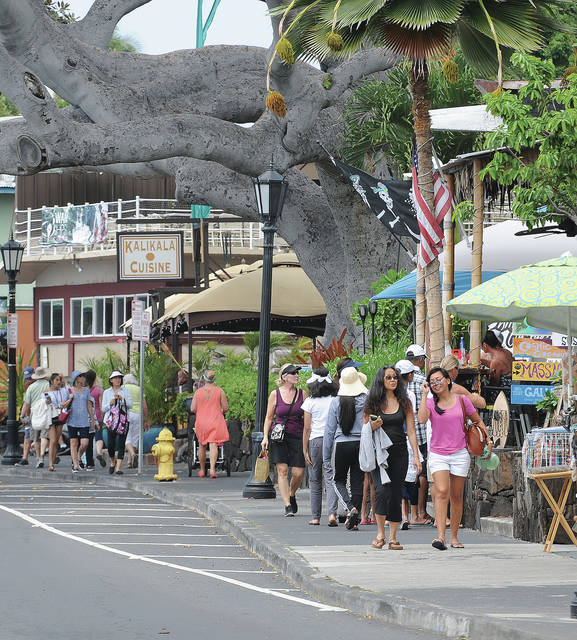Lava burning up tourism: Economic impact to Hawaii Island could be worse than thought

Visitors look at a map while awaiting a tour Tuesday at Greenwell Farms in Kealakekua. (Chelsea Jensen/West Hawaii Today)

The Body Glove gets ready to launch from Kailua Pier on March 21 when the MS Pride of America visited. The Body Glove bobbed idly throughout the day on Wednesday tethered to a mooring off Kailua Pier. Manager Michael Bell said the company lost both its tours, a full 200 passengers, from the cancellation of the MS Pride of America cruise ship. (Laura Ruminski/West Hawaii Today, file)


KAILUA-KONA — Kilauea Volcano’s awesome power extends beyond its ability to rattle and reshape the earth that surrounds it, destroying property and displacing the people who call those lands home.
KAILUA-KONA — Kilauea Volcano’s awesome power extends beyond its ability to rattle and reshape the earth that surrounds it, destroying property and displacing the people who call those lands home.
While physical damage and danger from the eruption is localized almost exclusively to Hawaii County’s Lower Puna region, the mountain’s fiery fits are wreaking havoc of a different sort across Hawaii Island — that of an economic variety.
Kilauea has grabbed two weeks worth of sensational headlines around the globe and made for fantastic storytelling opportunities, which have in turn conjured images for some of a pre-apocalyptic horror anxious to doom any who dare stray through its path.
“Believe it or not, the island is not getting ready to explode with the pieces showering the West Coast or something like that,” said Hawaii Island Chamber of Commerce president Bill Walter, whose organization is fielding dozens of calls daily from concerned visitors and potential visitors.
The results of skewed perceptions of events include the rescheduling and cancellation of planned trips as well as decisions not to book at all — a disconcerting prospect for an island community in a state where tourism generated nearly $17 billion in visitor spending and supported more than 200,000 jobs last year.
Booming to bombing
In reality, even despite volcanic activity in its southeast region, life carries on much as it always has across most of Hawaii Island. In other words, it’s business as usual.
Only because Kilauea has proved the “little story that could,” lingering at the top of mainstream media news programs since the first fissure began spewing lava May 3, actual business on Hawaii Island has been anything but normal.
“(Tour companies) are all seriously looking at revamping what their tour offers are to keep their employees on board,” said Island of Hawaii Visitors Bureau executive director Ross Birch. “They’re going to end up looking at downsizing their operations.”
Tourism was bound to slow as majority portions of Hawaii Volcanoes National Park remain closed due to safety concerns. The island’s most lucrative attraction, the park draws two million visitors annually and generates over $150 million.
Several news outlets reported earlier this week the island had already lost $5 million in tourism to the downturn caused by volcanic activity.
In actuality, it’s worse than that.
Birch said the $5 million figure applies strictly to lost lodging and activity company profits from May through June.
He surveyed roughly 110 accommodations and 60 activity companies to generate the figure, and $5 million is what he’s compiled with only 20-25 percent of those surveyed currently reporting.
“That’s just direct impact of the initial cancellations that we’ve seen,” Birch explained. “As long as there are sensationalized messages going on out there, we’ll expect this (trend) to continue.”
The more troubling development, Birch said, are reports that reservations for lodging and activity companies have dropped by 50 percent for June-August. Along with December-February, the summer stretch makes up for the year’s highest rate of tourist traffic.
Striking local
Acute impacts of the downturn were felt in Kailua-Kona Wednesday after Norwegian Cruise Line’s ship, MS Pride of America, announced it would forgo its scheduled stops on the island due to “adverse conditions” related to air quality.
Body Glove bobbed idly throughout the day, tethered to a mooring off Kailua Pier. Manager Michael Bell said the company lost both its tours, a full 200 passengers, from the one cruise ship cancellation alone.
Orinn Watanabe, branch manager at Enterprise Rent-A-Car on Luhia Street in Kona, said the company is somewhat isolated from tourism trends, doing much of its business locally in the form of replacement vehicles, for instance. However, the cruise ship’s absence cost Enterprise eight rentals.
A representative from Destination Kona Coast sent out an email Wednesday indicating Princess Cruise Lines planned to port a ship in Kailua-Kona as scheduled Thursday.
“It’s disappointing,” Kona-Kohala Chamber of Commerce president Wendy Laros said of reports from member organizations of cancellations stretching weeks into the summer. “I don’t know about alarming yet, but certainly disappointing.”
Companies relying heavily on the National Park have been hit hardest, Birch said, a few moving in a span of weeks from the best year of their existences to mass layoffs.
Gary Marrow, owner of KapohoKine Adventures, a Big Island-based tour company, said his business isn’t suffering to those extremes. However, Pele has forced Marrow to adapt.
Over the last two weeks, KapohoKine has altered 80 percent of its tour itineraries. The company has also sustained about a 30 percent financial loss, but Marrow said most of that has to do with the absence of cruise ships on the east side.
He was adamant the danger is isolated to a small area and there remains a great deal to see and do in East Hawaii, even with the park largely off limits. Walter, the president of the Hawaii Island Chamber of Commerce, agreed.
“It’s pretty hard to replace an erupting volcano,” he said. “But by the same token, some of the botanical gardens and some of these ziplines and the museums in town are all really fascinating, and you see some beautiful things.”
Rippling out
The vacation rental industry — which represents around 20 percent of the accommodations inventory on Hawaii Island, according to the Hawaii Tourism Authority (HTA), and lists more than 8,600 units on sites like Airbnb and VRBO — has also been scathed.
Hawaii County shut down all vacation rentals in the volcano-affected area over the weekend, but just as with traditional lodging, guest decisions are driving the downturn more than any other factor.
Airbnb is the third-largest vacation rental operation in the state, per HTA. A spokesman for Airbnb said 9 percent of bookings have been canceled islandwide since May 4.
“We’re working to assure visitors staying in other areas that Hawaii Island is safe and open for business,” Matt Middlebrook, Airbnb public policy manager for Hawaii, wrote in an email. “We recognize that the island’s economy is fragile and want to do all we can to support the community.”
Alaska Airlines, on the heels of cancellations, has offered round-trip fares to Hawaii Island for under $300 over the last week. Those types of discounts aren’t common yet, Birch said, as many businesses likely consider it “a little too early” for such action.
Controlling the message
HTA and the Island of Hawaii Visitors Bureau have minimal reach when compared to the likes of CNN and Fox News, and taking a step back is the current strategy.
“We’re really waiting for this to kind of become the old news,” Birch said. “We need the news cycle to die down a little before anyone will hear the message we’re sending out.”
Instead of putting their proverbial foot on the gas, tourism promoters are taking a beat.
“In times like this, we start to pull from advertising,” Birch said. “At least at the very initial stages.”
When dramatic depictions have lost their luster, the plan will be to ramp up the messaging. Birch said that will happen primarily through social media, where his organization spends most of its money already.
“We’re reaching out to hotel and activity partners to get the positive social media message out there,” said Birch, adding no one wants to discount in the process the tragedy suffered by the resident of lower Puna who’ve lost their homes.
He painted a picture of the image the bureau and its partners will try to promote.
“Hey, I’m sitting by the pool here in Hawaii. It’s a beautiful day, and you wouldn’t even know a volcano is going off.”



Any Marketing being done by the Tourism Board to reassure travelers? Friends from the mainland see nothing but bad news! I had a friend come over and they had a great time! Now is not the time to take the foot off the gas but to step up the game. Perhaps get a mainland marketing company to help out is the answer?
Aloha from Los Angeles. My family and I are planning on coming to Kailua Kona in late July. Does anyone know where I can get an accurate idea of the impact the volcano is having on the Kailua Kona area? Everything I’ve read appears to imply there are no issues to be concerned about, but I also continue to hear about air quality issues. Specifically, I would like to know, in plain, layman’s terms, does this mean Kailua Kona looks, smells and feels “normal”? Or should we expect to see “vog,” volcanic ash in the air, minute dust particles, and smell something in the air? I’ve read about earthquakes and acid rain, but we’re from LA, so that’s not a concern for us. I just want to get a sense of what we can expect. Do we need to buy and wear those protective face masks, for example? Thank you to any insight anyone can offer. Mahalo.
Kailua-Kona , and all of the Kona district and neighboring North and South Kohala districts are fine . Aside from slightly greater than the usual ‘vog’ some days in South Kona , nothing has changed .There is zero smell of anything volcanic in nature in the Kona and Kohala districts . The north side , where all the golf courses are, is much clearer of vog most days . The surf has been up slightly , the water conditions clear for diving , mango and lychee season are about here and the trees seem to be holding plenty . Its also been a rainy year in the uplands and everything is super green .
We just returned from Kona, and drove as far north as Waikoloa and as far south as Captain Cook, plus a day trip inland to Mauna Kea and back. Didn’t notice a thing, had a great time. I have no idea what the person up thread is talking about with a “serious health crisis” – nobody I spoke to in Kona or Captain Cook seemed bothered or worried in the slightest.
Thank You so kindly for the reports. Mahalo! 😉
No, nothing is normal here right now. The vog situation is horrible and many residents are getting very sick from it. The level of particulate in the vog is very high, and those particulates can settle in your sinuses, throat and/or lungs and cause major irritation that leads to infection. Doctors’ offices are overflowing, masks and air purifiers are sold out in local stores, and it’s actually a pretty serious health crisis. If you can stay on the Kohala Coast and not venture beyond the northern parts of the island (those are the ONLY areas relatively free of the vog effects), you should be fine. But the entire Kona Coast and Ka’u are places to avoid right now if you want to say healthy. Along with, of course, the parts of Puna that are directly affected by the lava flows.
Thank you wahine, but this is exactly the type of contradiction I keep seeing in the news: one person on one network reports one thing, and another person on another network reports conditions that, on their face, appear to completely opposite the previous reports. HELP!
She’s speaking the truth, Jillian, the vog is really bad, much worse than normal, and lots of my friends are getting sick, too. Stay north and you’ll be OK, Kailua-Kona and South Kona it’s so thick you can hardly breathe. Check out the web cam from the Sheraton – today you barely see 300 ft.
Help!
Go online and read today’s West Hawaii Today. The vog in Kailua-Kona is really bad and not likely to get better. Physicians are saying that a full 30% of the patients they are seeing are suffering from vog-related symptoms!
I checked out the Sheraton Keauhou webcam that Kawika referred to, Have a look for yourself (it’s on the See Hawaii Live site). Normally, from that point you can see all the way to Kailua-Kona; now, you can just make out the close point across the mouth of Keauhou Bay. Maybe a little more than 300 ft., but not much.
Of course, things could change drastically by July. But that’s the reality of what’s happening right now. If you want to avoid the vog, the “help” I can offer is to plan not to stay in North or South Kona, but to change your accommodations to North Kohala, or the north parts of South Kohala, where they may get a little vog, but in general the wind patterns leave that area pretty clear.
Thank you wahineilikea. You were right. We went. The vog was horrible. Never saw ONE sunset the entire time we were there. We should have just stayed closer to home and saved the money. I wish you all the best. We will return to other parts of Hawaii, but not Kona anytime soon. Anyone reading this who is thinking of going — believe this: it’s not like you smell it or it affects your normal breathing, but if you’re going to Kona, like we were, renting a house on a hill overlooking the ocean, then know: (1) you cannot see the ocean from even less than a mile away, (2) NO sunsets like the postcards, or what you may have enjoyed from other islands and (3) I don’t think this had much of anything to do with the volcano, but the humidity is absolutely STIFLING — worse than anything we’ve ever experienced anywhere else, including the east coast of the US, Florida and Mississippi. Except for time with family — which we could have enjoyed anywhere — this was absolutely the worst vacation ever, biggest waste of money and worst conditions of any trip we’ve ever been on . . . and we’ve survived 3 airplane disasters, a hurricane, 2 tornadoes, a tsunami and the MGM Grand Hotel fire in Las Vegas!
The air quality in Waikoloa was poor today. It looked dark outside by 5 pm.
I just visited and stayed in Kailua Kona, got back home to Phoenix day after yesterday. Everything felt normal to me. No smells, no ash. It seemed slightly hazy way in the distance one day, which was described as “vog”, but had no odor and wasn’t bothersome. We had a great time and nothing seemed to be wrong at all. I don’t know what the super alarming comment above was talking about – nobody I talked to locally described “major irritation” or “doctors offices overflowing”. Perhaps they are used to ultra-pure air in Hawaii and she is ultra-sentitive, but I checked the air quality levels every day I was always better than in Phoenix. Seriously, if you live in Los Angeles, you’re probably exposed to WAY worse air pollution on a daily basis, including sulphur dioxide (smog) than you’ll experience in Kona.
Thank You rmphoenix. Your insight helped ease my anxiety. Onward we shall go! 😊JillianB
Hey Big Island… See you in June. Aloha
Neal – San Diego
This is one took few days ago. Government did nothing to stand up and defend for our island.
https://uploads.disquscdn.com/images/b062bf6af16018dca3dec1ff1aaf53dc9c971dbdb5e26c11d6ac967b8cd69c36.jpg
That’s Kohala – the only area on the island relatively free of the really bad vog that we’re experiencing right now.
Keiki ponds near the old airport
And sitting in Holualoa right now I can barely see the old airport
Ah, OK.Then it certainly wasn’t taken any time in the last few days. Maybe 3 weeks ago!
This is crazy. The entire island is not safe. We can have very large earthquakes. We can have ash that rains down on the entire island, we can have gas emissions that make the air in Kona very dangerous to breathe, and we can have a tsunami that inundates every coastal region and they all can happen without warning. To say otherwise is irresponsible at best. But more likely criminal. For the government to allow the tourist industry to say all is fine is wrong. It’s time to face the fact that tourism needs to shut down until this crisis has passed island wide. And, when it does end we should only allow a limited amount of tourism in the future. Hawaii island is not Honolulu. This is not Disneyland. This is not some sort of fun zone where we can guarantee people’s safety. It’s time to face it, this is an active, and very dangerous situation.
Why don’t you catch a plane to Siberia. You should be safe from all the gloom and doom you see. Mean while I’ll be at the beach soaking up the sun.
This is a good lesson on just how fast things can change while other things remain the same. We now have fewer people on the island and less tax revenue but unfortunately we have the same number of government parasites to support. Things that will not change are $15/Day parking at the airport, our higher taxes, the additional DLNR regulations and environmental rules.
Events like this should offer an opportunity to reflect on what happens when people don’t come to Hawaii for what ever reason.
Sorry, but Hawaii is over rated. Crowded, polluted, militarized and many areas on the Big Island look creepy. Add high prices, traffic congestions, a few sand beaches and barely any sun shine. No thanks, there are other countries which offer cleaner and much nicer holiday experiences. Oahu, Maui are doomed and Big Island tries to copy it.
hopefully the the door hits you in the ass when you leave. By the way I bet your CREEPY. Maybe you’ll get lucky in another country and get your head chopped off. Aloha!
The best economic days of the Big Island are behind us for the short term. I don’t think that’s an over statement. The park is closed. Cruise ships are bypassing us. Visitor cancellations are coming in. The writing is on the wall. It is what it is.
Puu’oo has been erupting for the last 35 years. Did you just wake up. It’s the news channels ruining it for the big island. Remember all the other islands can fit on this island. We’re lucky, it’s a BIG ISLAND.
Long time residents of 20 years or more suffer from the cumulative effects of VOG.
Visitors are not affected by short duration of exposure.
i would not understate or overstate the continued impacts of volcano activity.
Hawaii Tourism Authority and Hawaii Visitors Bureau in their interests would not want to alarm tourism.
I would depend on Hawaii County Civil Defense authorities to issue alerts of physical or health dangers.
I would not be surprised if a volcano eruption transforms terrains and shorelines of the Big Island.